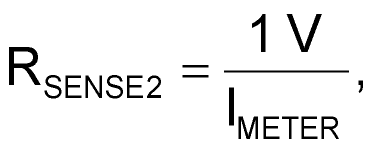A previous Design Idea describes an interesting and useful method for using a moving-coil analog meter to measure currents in the less-than-1A range (Reference 1). The design offers considerable flexibility in the choice of meter-movement sensitivity and measurement range and simplifies selection of shunt resistors. Although the design uses a bipolar meter-driver transistor, under some circumstances, a MOSFET transistor represents a better choice. The original circuit comprises a voltage-controller current sink that measures the bipolar transistor's emitter current, but the transistor's collector current drives the analog meter. A bipolar transistor's emitter and collector currents, IE and IC, respectively, are not identical because base current, IB, adds to the emitter current.
 |
|
| Figure 1. | This updated version of an earlier Design Idea uses a MOSFET to drive an analog meter display, offering great flexibility in power-supply-current measurement. |
You can express these current components as IE = IC + IB and then as IC = IE – IB. Whether base current adversely affects the measurement accuracy depends on the magnitude of IB and the magnitude of the common-emitter current gain, β, because base current IB = IC/β. When β is greater than 100, the base current's contribution to emitter current is generally negligible. However, β is sometimes smaller. For example, the general-purpose BC182, an NPN silicon transistor, has a low-current β of only 40 at room temperature. If you were to use a 15-mA-full-scale meter in the transistor's collector, full-scale base current IB at minimum β would amount to 0.375 mA. Subtracting base current from collector current introduces a 2.5% error.
But if you use a moving-coil meter that requires 150 µA for full-scale deflection, the measurement error increases considerably because β decreases as collector current decreases. For the BC182, reducing collector current from a few milliamps to 200 µA, current gain decreases β by a factor of 0.6 and adversely affects the meter reading's accuracy.
To solve the problem and improve the circuit's accuracy, you can replace the BC182 with an N-channel MOSFET, such as the BSN254 (Figure 1). Because a MOSFET draws no gate current, its drain current, ID, equals its source current, IS. When you select a MOSFET for the circuit, note that the device's gate-source threshold voltage should be as low as possible. For example, the BSN254 has a room-temperature gate-source threshold-voltage range of 0.8 to 2 V. The remainder of the circuit design proceeds as in the original Design Idea; that is, for a maximum voltage drop of 1 V across R1, you calculate RSENSE2 as follows:

where RSENSE2 is in ohms, 1 V represents the voltage drop across R1, and IMETER is the full-scale meter reading in amps.
Note that a 1-kΩ resistor at R1 develops 10 V/1 A output across sense resistor RSENSE1. In this application, 100 mA produces 0.1 V across RSENSE1, and the voltage across R1 thus corresponds to 1 V for full-scale deflection of the meter.
Reference
- Bilke, Kevin, “Moving-coil meter measures low-level currents”